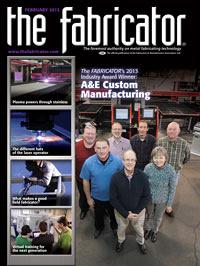Professor of Industrial and Manufacturing engineering
- FMA
- The Fabricator
- FABTECH
- Canadian Metalworking
Categories
- Additive Manufacturing
- Aluminum Welding
- Arc Welding
- Assembly and Joining
- Automation and Robotics
- Bending and Forming
- Consumables
- Cutting and Weld Prep
- Electric Vehicles
- En Español
- Finishing
- Hydroforming
- Laser Cutting
- Laser Welding
- Machining
- Manufacturing Software
- Materials Handling
- Metals/Materials
- Oxyfuel Cutting
- Plasma Cutting
- Power Tools
- Punching and Other Holemaking
- Roll Forming
- Safety
- Sawing
- Shearing
- Shop Management
- Testing and Measuring
- Tube and Pipe Fabrication
- Tube and Pipe Production
- Waterjet Cutting
Industry Directory
Webcasts
Podcasts
FAB 40
Advertise
Subscribe
Account Login
Search
Virtual training and documentation for manufacturing operations
Online guidebooks provide flexible, up-to-date instruction
- By Dan Waldorf, Ph.D.
- February 15, 2013
- Article
- Shop Management

Figure 1: Engineering students at California Polytechnic State University in San Luis Obispo relied on Internet-based guidebooks, viewed over a tablet computer, to learn how to maintain a Haas V-F2 vertical machining center. Photos courtesy of Dozuki.
Amidst the buzz of activity in a college laboratory a week before term projects are due, students cluster around a milling machine, heads bent in concentration as they scan between the machine and the iPad® mounted to it. This lab is full of advanced manufacturing machinery, which the students use in tandem with the latest technology to learn effectively, train quickly, and work safely.
This scene is a prime example of the “learn by doing” ethic that drives success in the engineering programs of California Polytechnic State University (Cal Poly) in San Luis Obispo. The education that students are offered at Cal Poly exists at the intersection of theory and practice. The goal is to prepare students to be leaders in their fields from the moment they graduate.
Firsthand experience with modern manufacturing equipment is an essential part of an engineer’s education. Every term a new batch of young engineers comes into the manufacturing laboratory and learns how to operate, calibrate, and repair such equipment.
Although a manufacturing laboratory seems removed from the traditional classrooms typically associated with a university, many of the same issues and technology solutions apply to both. In recent years higher education has been marked by an explosive growth of new technology integrated with current teaching methodologies. The Internet revolution has opened up tremendous opportunities for instructors to use technology to create better, more effective educational tools. Internet-based learning management systems, cloud storage, and the simple acceptance of the Internet as an everyday educational aid have made the transition to modern communications technology imperative.
These considerations also make technology integration an appealing option for learning about manufacturing equipment. Applied technology has the potential to change the way operators interact with their machines, especially when it comes to effective training and documentation. Over years of instructing students, I’ve found that equipment manuals can be burdensome to create and update, difficult to interpret, and lack the rich media typical in today’s computers. Demonstrations and face-to-face guidance on tasks are important, but a system of effective, step-by-step guides at an operator’s fingertips has the potential to increase efficiency and prevent errors.
Internet-based Learning Management
To test how much efficiency can be gained by integrating technology with machine tools, my students and I embarked on a yearlong experiment. Instead of extensive, one-on-one instructor demonstrations, we relied on an Internet-based visual instructions system from Dozuki to share some of the heavy lifting (see Figure 1). Students used Dozuki process documentation software to create and manage online technical assistance guidebooks: step-by-step instructions that incorporate photos, videos, audio files, and 3-D models. They then put those guidebooks to use right in our lab, with a computer tablet workstation attached to the equipment.
The guidebooks break operating and maintenance tasks down into manageable steps, each with photographs, text, pictures, video, and animation to assist the student. The interface allows for quick navigation across steps, links to tools, related issues, and a frequently asked questions section—all specific to the machine the student is operating.
In our experiment, Cal Poly students didn’t just use the guidebooks, they created them. Students selected a single piece of equipment--a Haas VF-2 vertical machining center—as their initial target for the guidebook development. The milling machine is maintained jointly by a professional technician and a student technician. Typical maintenance tasks include ensuring proper coolant circulation, establishing and correcting hydraulic fluid level and pressure, and setting up properly aligned fixturing elements on the main worktable. Students later documented all of these tasks with the software.
We purchased an iPad 2 with protective casing and lockdown for the project and installed it at the milling machine worktable. Student techs then could reference online guidebooks and FAQ pages. Employing a specialized mobile app provided as part of the Dozuki system, the iPad allows students to move from step to step (see Figure 2), view video clips or images, and zoom and focus on key tasks using touchscreen manipulation.
Because the online guide is editable, students could propose changes to the guide for my approval. With the iPad’s camera utility, they also could record new content and propose a visual update to the guide.

Figure 2: The virtual training materials, images, and even videos can accompany basic step-by-step instructions.
Technology Put to the Test
As an initial assessment of the project, 10 students, who had all received prior basic training on the machine setup and operation, were chosen for a pilot development group. They used the guides to set coordinate offsets, machine a flat face on their workpieces, clean, and then shut down the machine. In addition, one student was directed to complete the maintenance task of troubleshooting and correcting the machine’s tool changer error.
I found that student technicians who used the online wiki guidebooks enjoyed the experience of using the guides to complete maintenance tasks. In all cases but one, the students were able to complete the assigned tasks successfully without additional assistance. In the one instance when I was asked for help, I made a simple, immediate change to the guidebook, adding content so that future students could resolve the issue on their own.
Student operators seemed to enjoy the experience of using guidebooks on the iPad. Although a device manual was available, they appreciated the ease and rich media of the online guidebooks. Our initial results at Cal Poly show that the online guidebooks can provide an enjoyable environment for operators-in-training to successfully complete tasks without assistance from an instructor or other technician. I saved considerable shop management time by having the online guides available at the equipment site. And although student operators could create and add to the guidebooks themselves, I had administrative oversight to update guide iterations, which was especially crucial for documenting complex tasks.
Such a system holds promise for providing students and trainees with the guidance they need to perform basic operating tasks on their own. Regardless of the technical documentation available at a device, a student’s ability to see video demonstrations and follow step-by-step through a task at a chosen pace facilitates an effective learning experience.
About the Author
Dan Waldorf, Ph.D.
1 Grand Ave.
San Luis Obispo, CA 93407
805-756-1111
subscribe now

The Fabricator is North America's leading magazine for the metal forming and fabricating industry. The magazine delivers the news, technical articles, and case histories that enable fabricators to do their jobs more efficiently. The Fabricator has served the industry since 1970.
start your free subscription- Stay connected from anywhere

Easily access valuable industry resources now with full access to the digital edition of The Fabricator.

Easily access valuable industry resources now with full access to the digital edition of The Welder.

Easily access valuable industry resources now with full access to the digital edition of The Tube and Pipe Journal.
- Podcasting
- Podcast:
- The Fabricator Podcast
- Published:
- 04/09/2024
- Running Time:
- 63:55
In this podcast episode, Brian Steel, CEO of Cadrex Manufacturing, discusses the challenges of acquiring, merging, and integrating...
- Industry Events
16th Annual Safety Conference
- April 30 - May 1, 2024
- Elgin,
Pipe and Tube Conference
- May 21 - 22, 2024
- Omaha, NE
World-Class Roll Forming Workshop
- June 5 - 6, 2024
- Louisville, KY
Advanced Laser Application Workshop
- June 25 - 27, 2024
- Novi, MI































